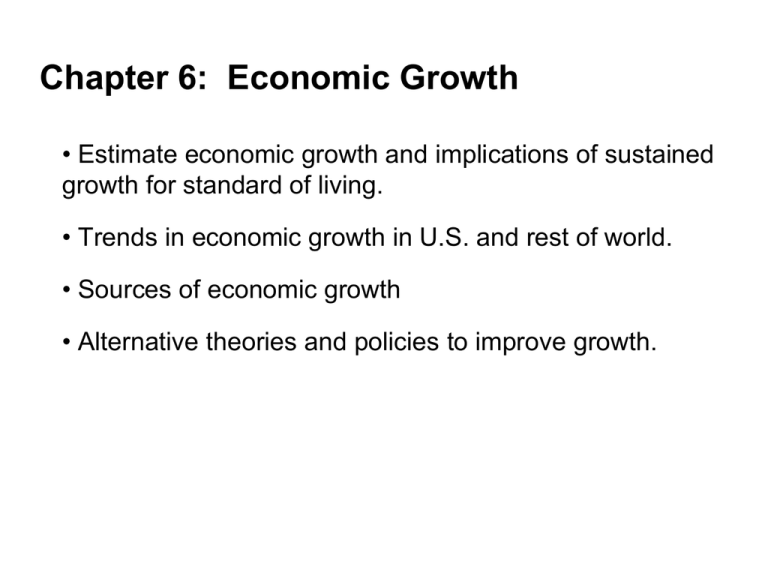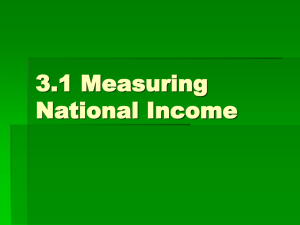Economic Growth
advertisement

Chapter 6: Economic Growth • Estimate economic growth and implications of sustained growth for standard of living. • Trends in economic growth in U.S. and rest of world. • Sources of economic growth • Alternative theories and policies to improve growth. The Basics of Economic Growth Economic growth •the sustained expansion of production possibilities •measured as the increase in real GDP over a given period. Economic growth rate = annual % change of real GDP. •Between two consecutive years: growth rate = (X2/X1)-1 •Over several years: Annualized growth rate = (XT/X1)1/T – 1 The Basics of Economic Growth •Standard of living depends on real GDP per person. •Real GDP per person grows only if real GDP grows faster than the population grows. • Rule of 70 number of years it takes for the level of a variable to double is approximately 70 divided by the annual percentage growth rate of the variable Trends in U.S Economic Growth Growth in the U.S. Economy From 1908 to 2008, annual growth in real GDP per person in the United States averaged 2% . Real GDP per person fell precipitously during the Great Depression and rose rapidly during World War II. Growth was most rapid during the 1960s. Growth slowed during the 1970s and sped up again in the 1980s and1990s. Trends in U.S Economic Growth Real GDP Growth in Developed Countries Growth in the United States, Canada, and Europe Big 4 has been similar. Japan grew rapidly in the 1960s, slower in the 1980s, and even slower in the 1990s. Economic Growth in U.S. vs. Poor Countries The gaps between real GDP per person in the United States and in these countries have widened. Sources of Economic Growth Economic growth is the sustained, year-on-year increase in potential GDP. •Potential GDP is the quantity of real GDP produced when the quantity of labor employed is the fullemployment quantity. •Short run fluctuations in real GDP resulting from the business cycle are not the basis for economic growth Determinants of Potential GDP Aggregate production function •Real GDP changes as the quantity of labor changes, other things held constant. •An increase in labor increases real GDP. •Diminishing marginal returns cause RGDP to rise at slower rate as L rises Determinants of Potential GDP Aggregate Labor Market •real wage rate – money wage rate divided by the price level. •demand for labor – shows the quantity of labor demanded as a function of the real wage rate. – determined by the marginal product of labor •supply of labor –shows the quantity of labor supplied as a function of the real wage rate. The Labor Market and Potential GDP Labor Demand Curve The demand for labor is the relationship between the quantity of labor demanded and the real wage rate when all other influences on hiring plans remain the same. Marginal product of labor curve is same as labor demand curve Firms will always hire workers if MP> real wage Profit maximizing firm hires until MP= real wage The Labor Market and Potential GDP Labor supply curve shows quantity of labor supplied for each real wage rate. Quantity of labor supplied increases as the real wage rate increases for two reasons: 1. Hours per person increase (assuming IE<SE) Income effect (work less if real wage increases) Substitution effect (work more if real wage increases) 2. Labor force participation increases Determinants of Potential GDP How Potential GDP Grows Increase in the supply of Increase in demand for labor labor • taxes on workers • population growth • demographics • retirement incentives • household technology • more productive labor •Human capital • physical capital • reduced payroll taxes on employers Effect of increase in labor supply • real wage • labor hours • real GDP • productivity (RDGP per hour) • real GDP per capita • depends on whether population increased Effect of increase in labor supply Effect of increase in labor demand due to increased productivity •Labor demand increases and PF shifts upward. •real wage • labor hours • real GDP • productivity • real GDP per capita Effect of increase in labor demand due to increased productivity Why Labor Productivity Grows The incentive system created by firms, markets, property rights, and money. The growth of labor productivity depends on • Physical capital growth • Human capital growth • Technological advances Accounting for Growth The quantity of real GDP produced, Y, depends on the quantity of labor, L, the quantity of capital, K, and the state of technology, T. Growth accounting •calculates the contribution of capital growth and technological change to labor productivity growth. One third rule (Robert Solow) • Estimated effects of capital on labor productivity •On average, with no change in technology, a 1 percent increase in capital per hour of labor brings a 1/3 percent increase in labor productivity Why Labor Productivity Grows Between 1973 and 1983, growth of labor productivity slowed to 1.7 percent a year. A collapse in the contribution of technological change (purple bar) brought about this slowdown in the growth of labor productivity. Why Labor Productivity Grows Labor productivity growth rate increased to 2 percent a year between 1983 and 1993 and … to almost 3 percent between 1993 and 2008. Technological change contributed most to this speedup in the growth of labor productivity. Growth Theories and Policies Classical growth theory •growth of real GDP per person is temporary and that when GDP per person rises above the subsistence level, a population explosion eventually brings real GDP per person back to the subsistence level. •Malthus – the “dismal science” Growth Theories and Policies Modern Growth Theory Real GDP per person grows because technological change induces a level of saving and investment that makes capital per hour of labor grow. Growth ends only if technological change and/or incentives for technological change stops. Growth Theories and Policies New growth theories • Real GDP per person grows because of choices that people make in the pursuit of profit and growth can persist indefinitely. •Technological change is driven by profit incentives • Knowledge is a public good and there may be increasing returns to knowledge (education) Growth Theories and Policies Achieving Faster Growth Growth accounting tells us that to achieve faster economic growth we must either increase the growth rate of capital per hour of labor or increase the pace of technological change. Stimulate Saving •Saving finances investment. So higher saving rates might increase physical capital growth. •Tax incentives might be provided to boost saving. Growth Theories and Policies Stimulate Research and Development •Because the fruits of basic research and development efforts can be used by everyone, not all the benefit of a discovery falls to the initial discoverer. •The market might allocate too few resources to research and development. •Government subsidies and direct funding might stimulate basic research and development. • Patents can provide incentive to innovate.









